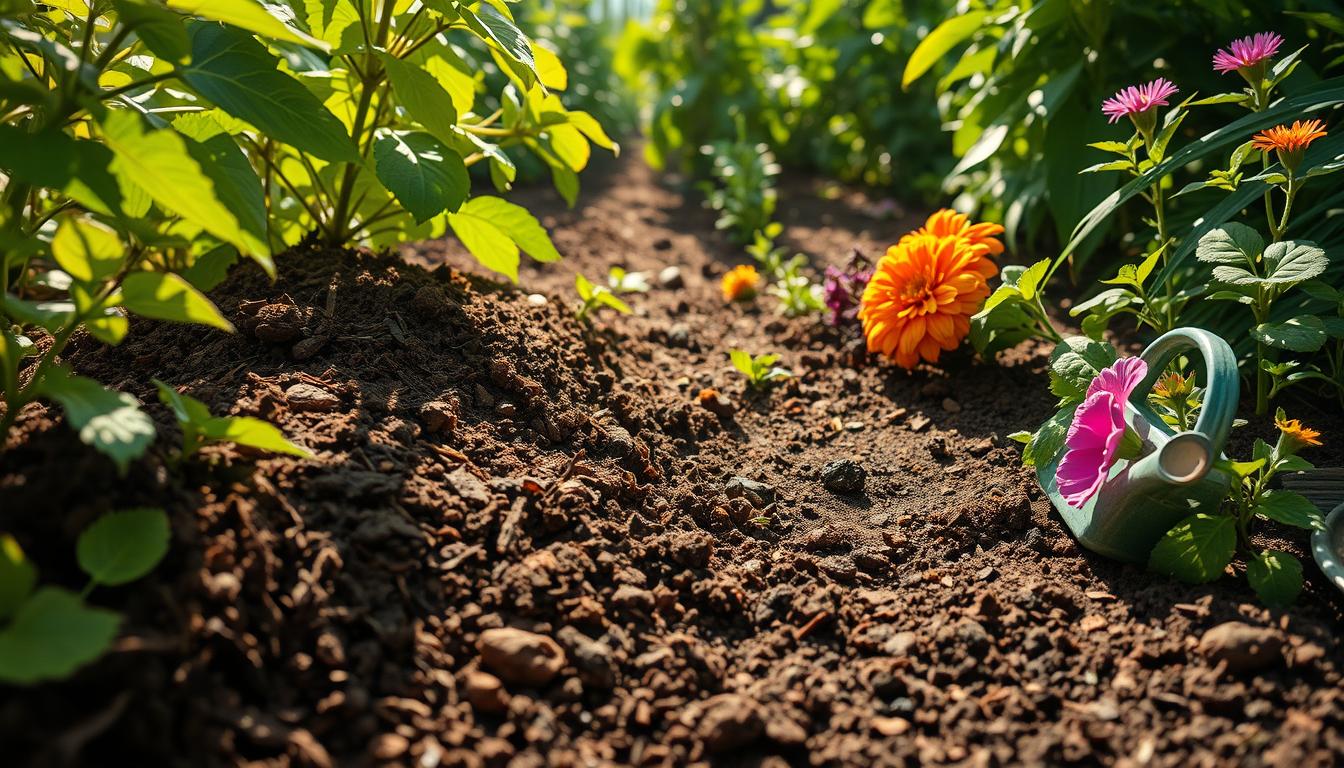I’m thrilled to share my top tips for soil and fertilizer with you. These tips will help your garden grow better. With the right knowledge, anyone can make their garden flourish.
We’ll dive into key gardening tips. You’ll learn about soil types and the best fertilizers. These tips are for both new and seasoned gardeners. They’ll make your garden healthier and more productive.
These 11 hacks will guide you to a lush, healthy garden. You’ll get the best advice on soil and fertilizers. I’m excited to share my knowledge and help you reach your gardening dreams.
Understanding Soil Types and Their Importance
To make your garden grow well, knowing about soil types is key. A plant nutrients guide helps you pick the right fertilizers. Improving soil quality takes time and effort.
Soil types include clay, silt, sand, and loam. Each has its own traits. Knowing your soil type helps you choose the best plants and fertilizers. For example, clay soil holds water, while sandy soil drains fast. Loam is a mix of clay, silt, and sand, perfect for most plants.
The Four Main Soil Types
- Clay: heavy, dense, and prone to waterlogging
- Silt: smooth, fertile, and easily compacted
- Sand: light, well-draining, and often nutrient-poor
- Loam: balanced, fertile, and suitable for most plants
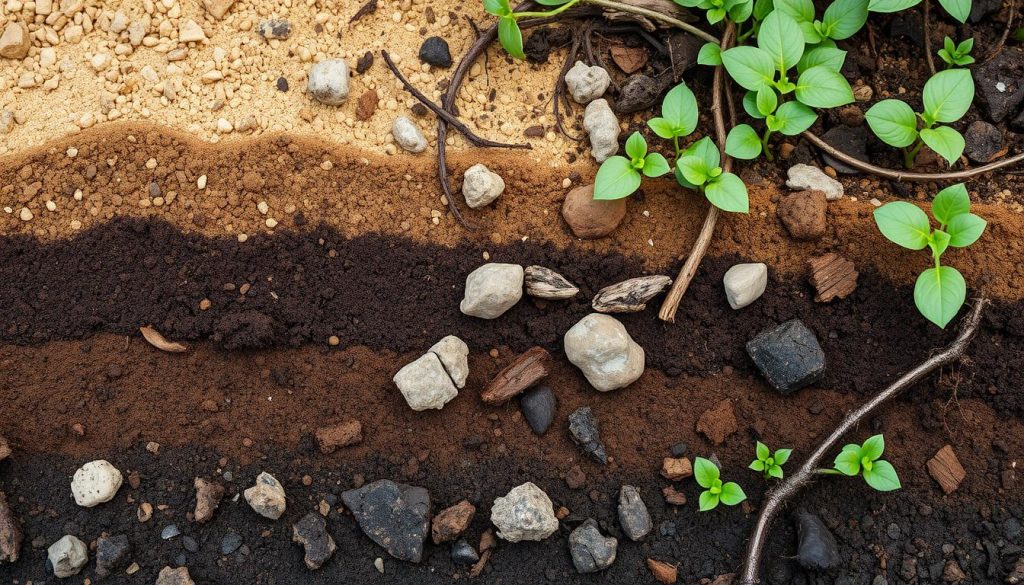
Understanding your soil type helps you improve it. This makes your plants happy and healthy. A good plant nutrients guide is essential for success.
Choosing the Right Fertilizer for Your Plants
Choosing the best fertilizer for your plants can be tough. There are many options, and knowing the difference between organic and synthetic is key. By using eco-friendly gardening tips and hacks, you can give your plants the nutrients they need. This section will help you make the right choice.
Organic fertilizers come from natural sources like animal waste or plants. They’re good for the environment. Synthetic fertilizers, made from chemicals, work faster but might not be as green.
Understanding Fertilizer Options
- Organic fertilizers: derived from natural sources, such as animal waste or plant matter
- Synthetic fertilizers: manufactured using chemical processes
To pick the right fertilizer, you need to know the N-P-K ratio. It shows the levels of nitrogen, phosphorus, and potassium. Choosing a fertilizer with the right N-P-K ratio helps your plants grow well. Using gardening hacks like composting and mulching can make your garden healthy and sustainable.
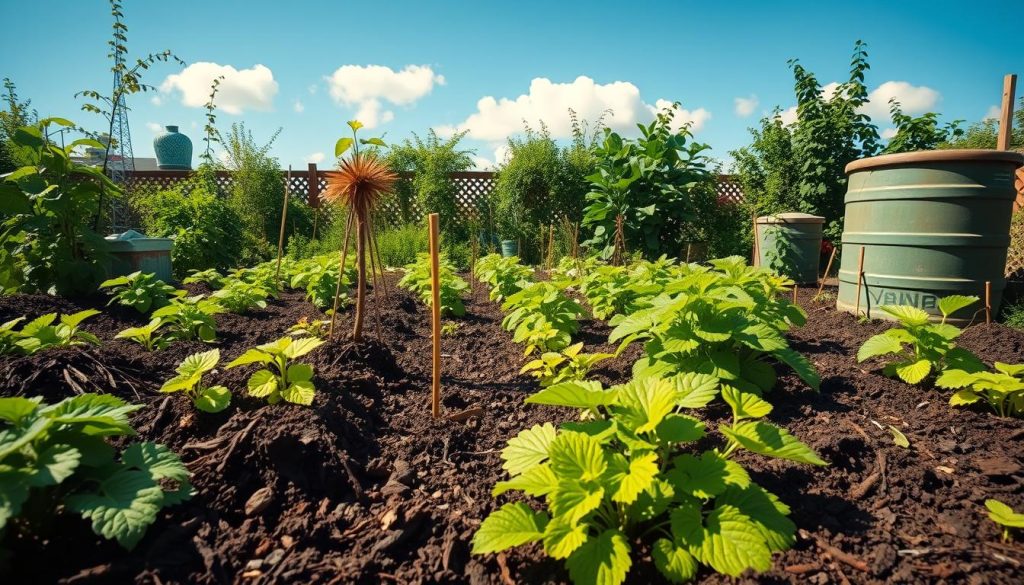
The Benefits of Composting
As a gardener, I’ve found composting to be a simple and effective way to enrich my garden’s soil. By following some basic tips and advice, I’ve improved my soil’s health and fertility. Composting is key to maintaining good soil health, as it reduces waste and creates a natural fertilizer.
To start composting, I suggest using a compost bin. It can be as simple as a wooden pallet or a plastic container. Once you have your bin, you can add materials like food scraps, leaves, and grass clippings. Here are some tips on what to add and what to avoid:
Getting Started with Composting
- Add kitchen scraps like fruit and vegetable peels, tea bags, and coffee grounds
- Incorporate yard trimmings like leaves, grass clippings, and branches
- Avoid adding meat, dairy, and pet waste, as they can attract pests and create unpleasant odors
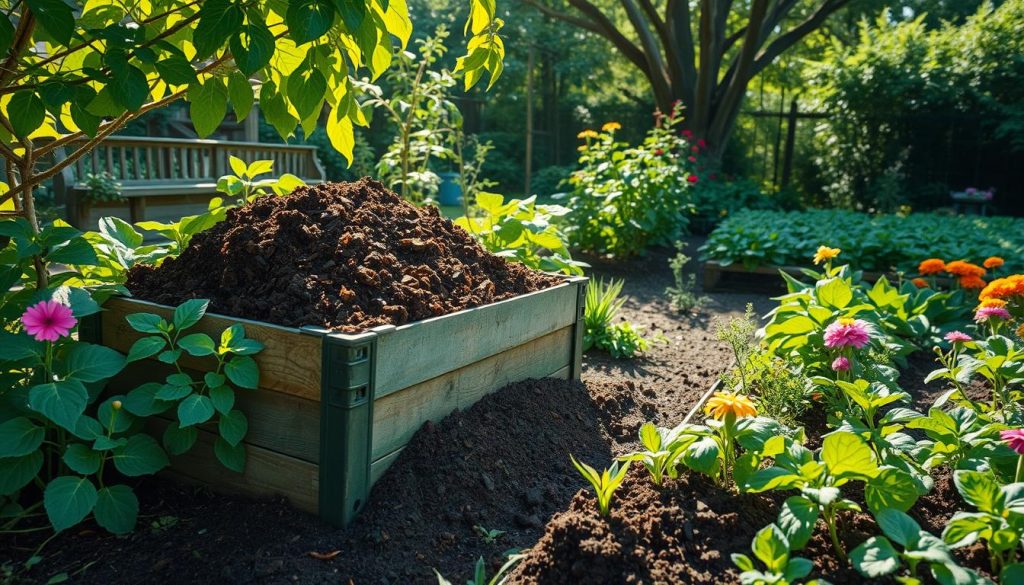
By following these tips and advice, you can create a balanced compost. This will improve your soil’s structure and fertility. Remember to regularly add compost to your soil and check its pH levels to maintain good soil health.
Mulching: An Essential Gardening Technique
Mulching is a simple yet effective technique for retaining moisture, suppressing weeds, and regulating soil temperature. As a gardener, I can attest to the benefits of mulching in improving soil quality and creating a healthy garden ecosystem. By incorporating eco-friendly gardening tips, such as mulching, you can reduce your environmental impact while promoting soil health.
When it comes to choosing the right mulch material, there are several options to consider. Some popular choices include organic materials like wood chips, bark, and straw. These materials are not only eco-friendly but also help to improve soil structure and fertility. Here are some benefits of different mulch materials:
- Wood chips: help to suppress weeds and retain moisture
- Bark: improves soil structure and provides nutrients
- Straw: helps to regulate soil temperature and prevent erosion
By applying mulch effectively, you can create a thriving garden ecosystem that requires fewer gardening hacks and less maintenance. Some tips for applying mulch include:
- Apply a 2-3 inch layer of mulch to the soil surface
- Keep the mulch a few inches away from plant stems
- Replenish the mulch as needed to maintain its benefits
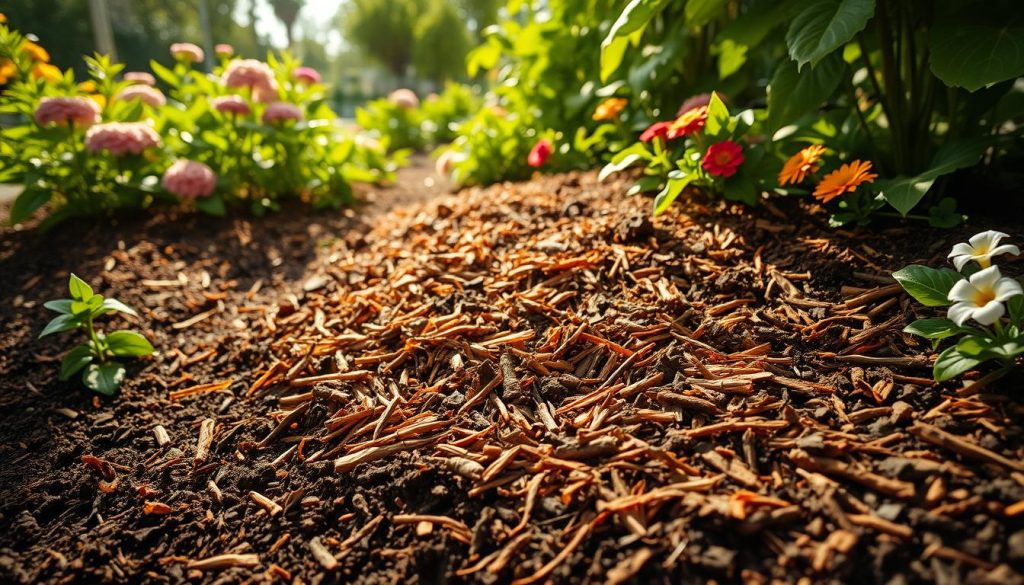
By incorporating mulching into your gardening routine, you can improve soil quality, reduce your environmental impact, and create a healthy and thriving garden ecosystem. Remember to choose the right mulch material and apply it effectively to reap the benefits of this essential gardening technique.
| Mulch Material | Benefits |
|---|---|
| Wood Chips | Suppresses weeds, retains moisture |
| Bark | Improves soil structure, provides nutrients |
| Straw | Regulates soil temperature, prevents erosion |
Timing Your Fertilizer Applications
To get the most out of your gardening, timing your fertilizer is key. Knowing the best practices and tips for your plants is crucial. A well-planned fertilizer schedule can greatly improve your plants’ health and productivity.
A plant nutrients guide can show you the right fertilizer amount and type. During the growing season, plants need more nutrients for growth. Adjust your fertilizer schedule based on seasonal needs and plant responses.
Signs your plants need more nutrients include yellow leaves, slow growth, and less fruit. Adjusting your fertilizer schedule can help. Here are some tips:
- Start with a balanced fertilizer that provides equal amounts of nitrogen, phosphorus, and potassium
- Adjust your fertilizer schedule based on your plants’ specific needs and growth stage
- Consider using organic fertilizers, which release nutrients slowly and promote healthy soil biota
By following these tips and best practices, you can have a thriving garden. Always follow a plant nutrients guide and watch how your plants react to different fertilizers. This ensures you’re giving them the best care.
The Role of pH in Soil Health
Soil pH is key to how well plants get nutrients. As a gardener, knowing about soil pH is crucial. It helps plants grow well. By testing and adjusting the pH, you can make your garden better.
Testing Soil pH
To find your soil’s pH, you can buy a testing kit or send a sample to a lab. This tells you if your soil is too acidic or too alkaline. Then, you can use eco-friendly tips to balance it out.
Adjusting pH Levels Naturally
You can change soil pH naturally with organic stuff like compost, manure, or peat moss. Lime raises pH, while sulfur or peat moss lowers it. Here’s how to do it:
- Add compost to raise pH and improve soil
- Use manure to add nutrients and lower pH
- Apply peat moss to lower pH and improve acidity
By using these tips and natural amendments, you can make your soil better. Always follow good gardening practices to keep your soil healthy.
| pH Level | Soil Type | Plant Growth |
|---|---|---|
| Acidic (0-6.0) | Sandy or peat-based soils | Optimal for acid-loving plants like azaleas and blueberries |
| Neutral (6.0-7.0) | Clay or loam soils | Supports a wide range of plant growth, including vegetables and flowers |
| Alkaline (7.0-14.0) | Calcareous or limestone-based soils | Optimal for plants like cacti and succulents that thrive in alkaline conditions |
Incorporating Cover Crops
As a gardener, I’m always searching for new ways to make my garden better. Cover crops are a key part of this. They help improve soil health and add variety to my garden. By following organic gardening tips, I can make my garden strong and full of life.
Using cover crops is easy and helps a lot. They stop soil erosion, make the soil better, and boost garden health. Some great things about cover crops are:
- Improved soil fertility and structure
- Increased biodiversity and ecosystem services
- Reduced soil erosion and nutrient loss
Benefits of Cover Cropping
Adding cover crops to my garden has many benefits. For instance, legume cover crops like clover and beans add nitrogen to the soil. This means I need less synthetic fertilizers and my soil gets healthier.
Best Cover Crops for Your Garden
Here are some top cover crops for my garden:
- Clover: a legume that fixes nitrogen and improves soil fertility
- Rye: a grass that reduces soil erosion and improves soil structure
- Radish: a root crop that breaks up compacted soil and improves drainage
Understanding Soil Amendments
As a gardener, I’ve found that soil amendments are key to a healthy garden. They improve soil structure, fertility, and health. With the right tips and guide, you can make your garden flourish. We’ll look at common soil amendments and how to use them well.
First, let’s talk about the types of soil amendments. You have organic options like compost, manure, and peat moss. Then there are inorganic ones like fertilizers and lime. Choosing the right ones can make your soil better for plants.
Common Amendments and Their Uses
- Compost: adds organic matter and improves soil structure
- Manure: provides nutrients and supports microbial activity
- Peat moss: helps retain moisture and suppress weeds
- Fertilizers: provide essential nutrients for plant growth
When using soil amendments, it’s important to do it right. Over-fertilizing can harm your plants. By following a guide and using tips, you can help your soil and plants thrive.
How to Apply Soil Amendments Effectively
To use soil amendments well, start with a soil test. This will tell you about your soil’s pH and nutrients. Then, pick the right amendments and apply them as suggested. This way, you’ll have a garden that’s healthy and full of life.
Watering Wisely for Healthy Soil
As a gardener, I’ve learned that watering is key. It can make or break soil health. To improve soil, it’s vital to water wisely. This means considering what my plants need and using eco-friendly tips for efficient watering.
By doing this, I create a garden that thrives. It’s a garden ecosystem that benefits from my gardening hacks.
To water efficiently, I use a few simple methods. I check soil moisture by inserting my finger into the soil. I also use a rain gauge to measure rainfall and adjust my watering schedule. Watering deeply but infrequently encourages deep root growth, which improves soil quality.
Techniques for Efficient Watering
- Water plants in the early morning or evening to reduce evaporation
- Use a soaker hose or drip irrigation to deliver water directly to the roots
- Mulch around plants to retain moisture and suppress weeds
Using these eco-friendly tips, I reduce water waste. I create a healthy soil environment that supports plant growth. Remember, watering wisely is a crucial gardening hack. It can significantly improve your garden’s health and productivity.
Attracting Beneficial Soil Organisms
As a gardener, I’ve found that earthworms and other beneficial soil organisms are key to healthy soil. By following organic gardening advice, I’ve made my garden a thriving place. Adding compost or manure to the soil is a great way to attract these helpful creatures.
Here are some tips to help you create a biodiverse soil ecosystem:
- Add a mix of “green” and “brown” materials to your compost pile to create a balanced ecosystem
- Use organic gardening advice to choose the right plants for your soil type and climate
- Avoid using synthetic fertilizers, which can harm beneficial soil organisms
By following these tips and using organic gardening advice, you can make your garden strong and healthy. Always choose tips that support biodiversity and soil health.
Troubleshooting Common Soil Problems
As a gardener, I’ve faced many soil challenges. Issues like compaction and poor drainage are common. It’s key to know how to fix these problems to keep your garden healthy.
Identifying Compaction Issues
Soil compaction hinders plant growth by limiting air, water, and nutrient flow. Look for signs like slow water absorption, stunted plants, and moss or thatch. To fix it, try aeration, adding organic matter, and using cover crops to enhance soil structure.
Dealing with Poor Drainage
Good drainage is vital for healthy soil and plants. If water pools or plants struggle, drainage is likely the issue. To solve it, add compost or organic amendments to improve soil’s ability to drain. Also, consider raised beds or drainage systems. By tackling these problems, I’ve created a lush, eco-friendly garden that blooms every year.

